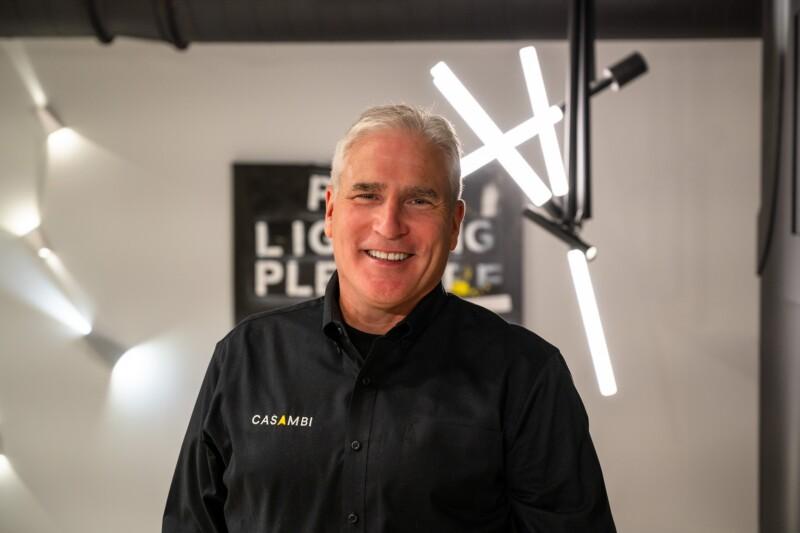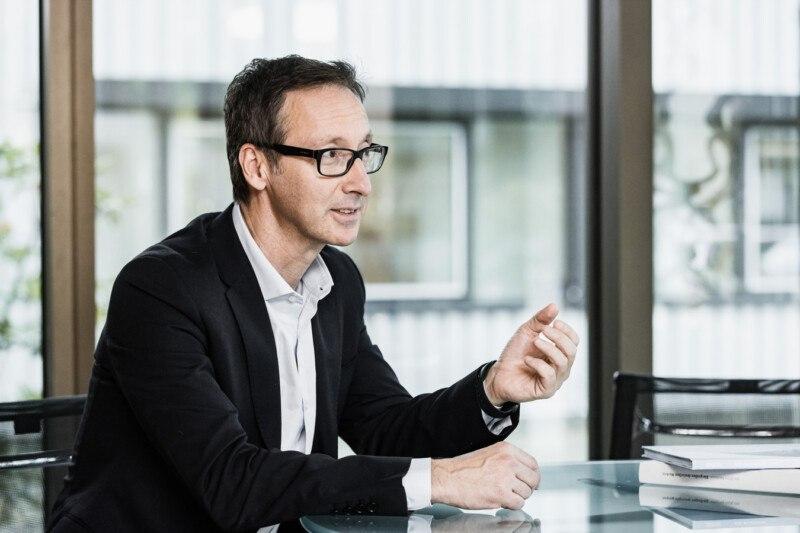A legendary lighting designer’s take on technological change

Emerging technologies can put the art back into lighting control. Since lighting designers are the ones who must put new tech to work effectively, gaining their buy-in is a surefire indicator of a solution’s eventual marketplace success. Lighting designer and technologist, Kevan Shaw, gives a lowdown on the evolution of lighting control, and his candid perspective on navigating change against the vast tide of technological solutions becoming available today.
If you tuned in to our recent Summit, you’ll have very likely watched Kevan Shaw’s keynote entitled ‘A point in time for technology’ during which he spoke of a lighting control industry in transition and took us on a whistlestop tour of the changing landscape. We caught up for a post-event convo.
Once upon a time, explains Kevan, we were either controlling the power to dim a filament, and you would have to try something clever to dim an arc – unsuccessfully overall. And with fluorescents, there was an intermediate process where you tried to get the discharge to vary in the tube. These were quite savage candle tricks!
Then we moved away from legacy light sources to LEDs and experienced an entirely new phenomenon as discrete electronic components – semiconductors – entered the game. The integration of chips allowed for the intervention by means of high-precision smart control.
As we gradually move away from ‘brutal technologies’, as Kevan puts it, into an era of wireless wizardry, smart lighting control promises new levels of consumer satisfaction like never before… providing the technology works and people are ready to master it.
“This isn’t about lighting. This isn’t about technology. This is about psychology”.
Today, lighting designers need to know so much more about electronics. Kevan explains that it’s not only the ‘old-timers’ (his words not mine!) who need to be brought up to speed and reeducated in the electronics movement. He’s noticed that lighting school graduates are entering the industry without really knowing anything about the nitty-gritties of electronics, lighting control systems, or communication protocols. Young people just don’t have that knowledge.
For Kevan, now’s the time to pose the hard questions. The industry is transforming. How should we adapt? What should we embrace? Will incremental change cut the mustard? Will adding new technologies at the edges do the trick or simply create more complexity? Is it time for an entirely ‘out with the old, in with the new’ approach?
‘DALI was designed to work with legacy light sources. And DALI2 was created for LED-friendly control. The latter is somewhat held back by its forebearers and hemmed in by a robust-yet-too-slow transmission protocol. If the market moves towards an entirely digital, wireless communication system, DALI could become redundant. But owing to its market penetration, it is instead becoming the interface between wireless networks and the light fitting. To replace DALI requires putting redundancy into products, which increases costs. For new, emerging technologies to prevail, they first need to achieve more market penetration before players feel it cost-effective to integrate new protocols natively from the beginning. It’s a big mountain to climb’.
Kevan contends that this change starts with ballast and gear manufacturers. This is because they need to be integrating a wireless solution [ahem …. Casambi] as they build the backside of their gear to be able to work at speeds, and they need to be able to increase the capacity of their downstream components to be able to work at a speed that a wireless network can operate at. That’s a big chunk of change to do, Kevan concedes.
There’s also an aversion to change that is entrenched in the psyche. Lighting designers and engineers are trained in the ways of DALI. To do things in a new way, as rational as that new way may seem, the vast majority of experts are setting themselves up against all that hard wiring (excuse the pun), all those emotional connections to those who taught them the old way – and that’s not trivial. How do you disrupt officialdom?
The evergreen wired vs. wireless debate
The ‘change’ debate – or the justification thereof – is often boiled down to wired versus wireless, whereby traditionalists feel wired lighting control is more secure as it is physical, and you can touch it. Whereas wireless is unpredictable because it feels abstract and unknown.
Kevan takes a pragmatic view of things. For him, wired works only when the wired system is installed by people who understand what they are doing. Do it properly and it doesn’t screw up. Once it screws up – because it’s in the building – it’s permanently screwed. So, you still need to rely 100% on your installers and on all the other parties down the line, from the lighting designers to the electrical consultants, and commissioning engineers. Wiring is not always the secure route, working with knowledgeable people is.
‘And the same goes for Bluetooth and other wireless-based systems. It can be argued that you kind of move the problem. Because the problem isn’t so much a physical one, it is a knowledge-based one. You need to employ people who understand the software, and the inter-relationship with the radio-networking side of it, it all needs to be lined up’.
‘We’re trained in a way that seems to be missing the mark – you read how things should work, how things should be put together. You read what’s supposed to work with what. But until you actually start plugging things together you don’t understand the limitation or how any two pieces might work or what gaps exist in the logic chain in order to get something up and running.’
‘Non-standard thinking, practical experience, and learning on the job need to happen’.
For lighting designers, the interoperability question is a big one.
‘We need interoperability between every different lighting component we wish to propose to a scheme. In an ideal world, we shouldn’t have to think about it, let alone study the spec sheets only to realize that the desired products are incompatible’.
‘Casambi has taken an interesting turn on this. You’re offering a protocol, software, and components rather than selling end products. This approach makes it more open; it makes the adoption by manufacturers much easier because they don’t have to do the thinking’.
Having said that, Kevan suggests there needs to be greater provision of careful support or guidance to designers during such a period of change (in this instance towards attaining wireless mastery). The starting point is for lighting designers to better understand how radio works.
‘It’s still magic. Designers need to know what blocks radio signals, they need to know what a Faraday cage is, and they need to appreciate that a metal grid on a ceiling let alone a paneled ceiling can completely screw up radio. That a damp-stone wall is less likely to pass a radio signal than a dry-stone wall. This all needs to be taught in order for people to comfortably implement these technologies.’
Long-life lighting
Another key consideration for lighting designers as they embark on a project is predicting what will happen over the lifetime of a system.
Up until the advent of LEDs, the industry became accustomed to very long-life light fittings, where the wear-out component – the lamp – was regularly changed. So, a thirty-year-old lighting system is not necessarily made redundant. Kevan’s company, KSLD, has even dealt with 100-year-old church light fittings that they’ve successfully brought back into service. But this is not the way with LEDs. The failure mode in lighting systems these days is electronic, for which there is a range of pernicious failures that reach way beyond the changing of a light bulb.
‘As we’re moving into the software game, and utilizing digitally-driven solutions, can we rely on long-term thinking? How will Casambi and the lights continuously support products into the future? This is the huge and vital question. There is absolutely no point in the lighting industry making refurbishable luminaires or starting to build a whole secondary industry on remanufacturing, refurbishment, and repairs if the key components which become digital are not going to be properly supported over time.’
A key selling point with software is that you can constantly change it, improve it, and enhance it. Casambi can dynamically update its wireless system in the field. Over-the-Air programming allows the company to push new software features and additional functionality out to the entire fleet of installed devices at once, keeping all units interoperable. It’s this software-driven mechanism that allows constant and fast evolution, reacting to real market needs and, more importantly, extending the lifespan of installed devices.
By going wireless with Casambi, any additions or changes to lighting installations can be easily implemented in the Casambi app. It is possible to add or remove luminaires, move switches around, and add new functionality and new scenes at any time. It is all done in the software. In this way, the latest and most energy-efficient light sources can be taken into use as soon as they come onto the market.
‘Another thing that’s appeared on the radar is capacitor failure. That is the killer for electronic gear. Because we still have to rely on fairly chunky electrolytic capacitors in any of the power-control bits of equipment. As long as we’ve got an LED that is transforming an AC supply to a DC supply and usually in a fair chunk, you’ve got capacitors – the only tool we have at the moment that allows moving from AC ripple to something resembling DC. Until we get rid of capacitors we’re going to remain with that life-limiting component involved. 30 years is a push for commercial range capacitors in power applications’.
Handling complexity
Kevan challenges that the world of wireless entails working in layers; IoT systems utilize building blocks from different players to build code. Some industry players are building code in languages that are quite high-level, which means there is a whole other sublevel of code that can be flakey. What will wireless projects deployed today look like in 20 years to come? Will we be able to realistically spend time, resources, and people-power debugging 20-year-old code to understand why something has gone wrong, he asks.
When we’re talking about modern, smart, highly complex systems – no matter whether you have standardized it or are constantly evolving it, as Casambi does – there’s no way that somebody could introduce a method whereby you create totally bug-free code. Standards are not the silver bullets – they still have software logic on the implementation side. So, on an ecosystem level, it gets more complicated because there are multiple parties that are interpreting a standard to create their own version, and thus creating their own bugs. With Casambi, at least, there is one entity accountable for the whole – Casambi.
Then it becomes a question of trust – that you will not be held ransom to a solution provider that holds the knowledge you, yourself, do not. In this instance, market mechanism keeps the provider honest; if a company is doing unreasonable things, it opens the door to another competitor. This applies to standard-based systems as much as proprietary.
The lighting industry has been exceptionally stable for hundreds of years. We have the E27 bulb – named so in homage to Edison who standardized the screw back in the late 1800s. The secret to centennial smart lighting tech companies will pertain to three fundamentals; a reliable offering, attention to new developments, and more so, demonstrating a genuine willingness to identify with the customer’s problems.
From the lighting designer’s perspective
Kevan maintains that it’s important for a lighting designer in her/his work to know about the development of leading-edge technologies. This is to some extent achieved through self-learning, self-development, and self-initiated engagement. However, deeper, hands-on education should be volunteered by the technology providers. Sometimes, there exists a divide between the marketing messages based on ‘how the tech works under perfect circumstances’ and then there’s the ‘how to master the technology when faced with technological blockers that haven’t been well understood’.
‘There sometimes exists a disconnect between messaging and realities (the ‘alsos’). The company that owns the technology needs to be able to teach it, not just communicate it.’
We hear you, Kevan!

Interested in learning more about Casambi? Drop us a note, and we’ll reach out to you:


